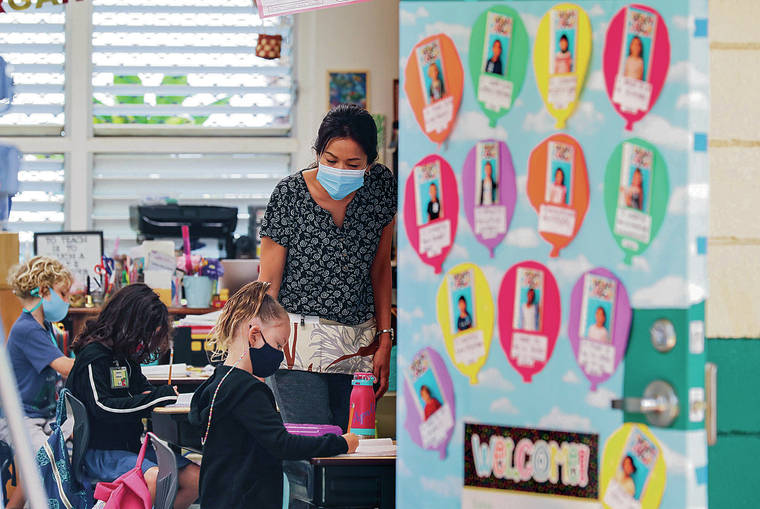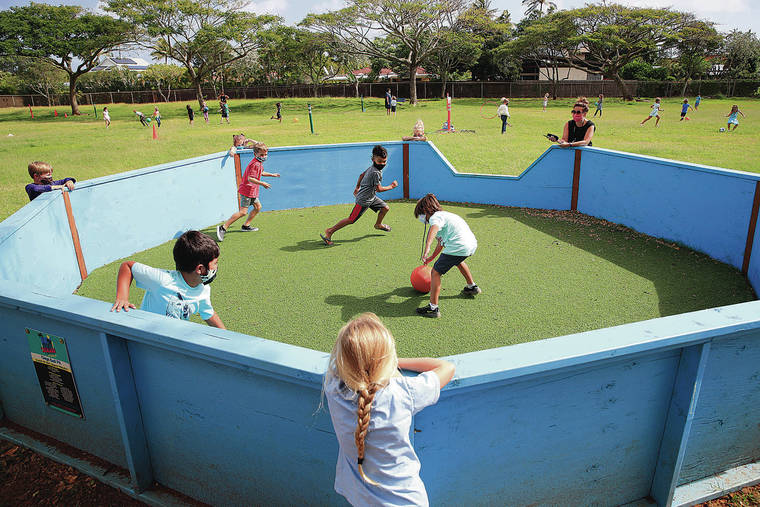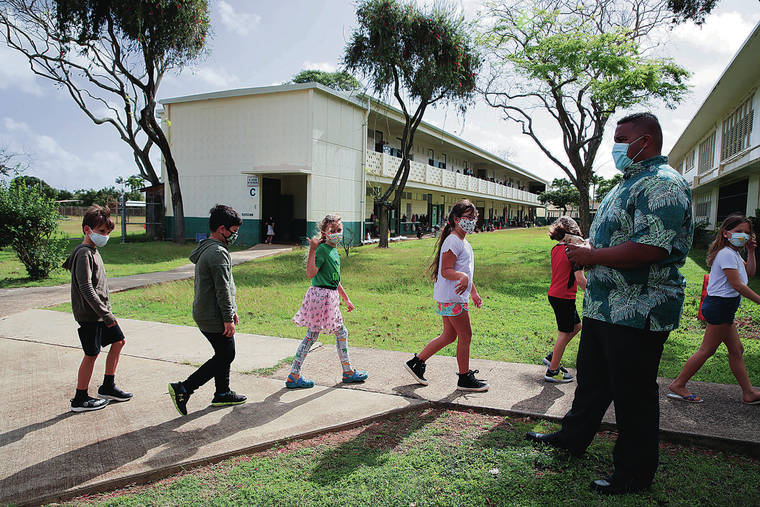Hawaii students are returning to campuses under new CDC guidelines

JAMM AQUINO / JAQUINO@STARADVERTISER.COM
Kindergarten teacher Sarah Sunada conducted lessons Monday at Aikahi Elementary School.

JAMM AQUINO / JAQUINO@STARADVERTISER.COM
First graders engaged in a socially distant game of gaga ball during recess.

JAMM AQUINO / JAQUINO@STARADVERTISER.COM
Aikahi Elementary School Principal Keoki Fraser, right, greeted sixth graders Monday as they returned from first recess. All but about 5% of the students enrolled at the Kailua campus have resumed in-person classes under pandemic protocols put in place and monitored by a “safety hui.”



Precisely a year after Hawaii public schools switched to distance learning due to the coronavirus, nearly the entire student body at Aikahi Elementary School flocked back to campus Monday.
“Today’s the big day — almost everyone’s back today, so everyone’s excited,” said Tessa Amell, who used to be a kindergarten assistant but now is part of the “safety hui” that helps ensure kids follow pandemic protocols at the Kailua school.
“Some of these kids, they got picked up for spring break last year, and they just never came back,” she added. “So being able to be around their peers, even though it’s in a heavily monitored situation, has been amazing.”
Altogether, 430 out of 460 Aikahi students returned Monday for daily face-to-face learning, dutifully wearing masks, sanitizing and following spacing rules yet exuberant in their reunion on the first day after spring break.
“I feel really happy because I get to see a lot of my friends, and we get to do stuff as a class,” said sixth grader Kealamaihiki Gossert as her classmates played a vigorous game of kickball in the sunshine during recess.
Over the course of the school year, Aikahi first brought back its vulnerable kids and then its younger grades for full face-to-face learning. In January the older kids returned for hybrid learning, alternating days on campus to allow for adequate spacing in classrooms. Now all are back, save for about 5% still opting for online learning.
Don't miss out on what's happening!
Stay in touch with breaking news, as it happens, conveniently in your email inbox. It's FREE!
“This quarter, we had the most parents transition their kids back to school,” said Principal Keoki Fraser. “I think they have confidence in what we’re doing. … It takes a lot of training and practice and good people; that’s all it is — it’s not rocket science.”
The Department of Education’s goal is for all elementary schools to bring back as many students as is possible safely for in-person learning in this fourth quarter. Some started Monday, and others are ramping up over the next couple of weeks. By April 5, for example, all Kauai elementary schools will offer the option of daily, in-person learning with strict mask-wearing and cohorts to minimize mixing.
The statewide move toward face-to-face instruction is likely to accelerate under the newest federal guidance Opens in a new tab that allows students to be 3 feet apart in classrooms so long as they are masked. The Centers for Disease Control, which previously advised 6 feet of distancing when possible in classrooms, relaxed that stance Friday after research in the United States showed no significant differences in COVID-19 transmission rates with the closer distance in classrooms.
The World Health Organization has long called for distancing of one meter (3.3 feet) for students in classrooms, and many countries have prioritized keeping their kids in school using that standard.
The CDC cited studies from Utah Opens in a new tab and Missouri Opens in a new tab, published Friday in its Morbidity and Mortality Weekly Report, that “build on evidence that physical distancing of at least three feet between students can safely be adopted in classroom settings where mask use is universal and other prevention measures are taken.”
A statewide study in Massachusetts Opens in a new tab, published March 10 in the Journal of Clinical Infectious Diseases, also found no significant difference in coronavirus rates in schools with consistent masking whether students were 6 or 3 feet apart.
“Given the crucial services schools offer and the benefits of in-person learning, it is critical for K-12 schools to open and remain open for in-person instruction, as safely and as soon as possible,” the CDC wrote in the guidance. “Schools should be the last setting to close because of COVID-19 and the first to reopen when they can.”
Aikahi Elementary has been operating under the 6-foot distancing rule and continues to do so in most of its classrooms, although some of the upper-grade classrooms now have desks spaced at less than 6 feet, Fraser said. The principal shifted some staff to allow for smaller class sizes, with the technology coordinator and physical education teacher both returning to classroom teaching.
Grade levels do not interact, in order to preserve cohorts and minimize any possible spread. Recesses and lunches are staggered. Older kids eat outside on benches, including a brand-new one that runs the length of the covered breezeway linking school buildings. Sanitization takes place regularly.
Louvered windows remain wide open in classrooms, allowing in breezes, and high-efficiency filters have been installed where needed. Bright-blue sails, a reference to Aikahi’s Wind Riders mascot, stenciled on benches and floors help students know to keep their distance.
First grade teacher Kiani McBean said she was delighted to welcome back her students to her classroom in January, since online instruction was quite a challenge for that age group.
“They’re 6 years old, so to sit in front of a computer even for two hours with me, it’s a lot to ask,” she said. “And then also, they do need someone there to show them how to do things.”
She said some families had initial apprehension about coming back, but that faded quickly.
“We all feel really safe here — the students, the teachers. We’re just really happy that we can be back together,” McBean said. “The most important thing is the procedures and protocol, and if you have those locked in place, then you can create such a safe environment.”
More than a third of Aikahi’s student body opted for full online learning at the start of the year, but that has dwindled to roughly 5%. Those students are assigned distance-learning coaches.
Still, all Aikahi students have had at least several months of online classes. Kealamaihiki, the sixth grader, recalled that “it was kind of lonely, and it was kind of hard because I didn’t have a lot of instruction.”
Even blended learning with rotating days on campus, she said, was challenging for her classmates and their teacher, who had to simultaneously handle kids in her classroom as well as ones tuning in from home.
“She has an easier time controlling all of us because usually she would have to speak to the online kids and then speak to us and then give them instruction and then go back and forth,” Kealamaihiki said.
A member of the school’s news team, the 11-year-old and her colleagues have been keeping their school informed with their video news show Opens in a new tab. A new seven-minute episode Opens in a new tab aired Monday, with tips on everything from what was on the lunch menu to welcoming back classmates without hugging.
How close is too close?
The Centers for Disease Control and Prevention updated its guidance for schools Friday. It relaxed some distancing rules, saying research shows no significant difference in coronavirus transmission rates in classrooms with students spaced 6 or 3 feet apart, so long as everyone is masked.
THE NEW ADVICE
>> All elementary students should be seated at least 3 feet apart in classrooms where mask use is universal, regardless of whether community transmission of coronavirus is low, moderate, substantial or high.
>> Middle and high school students should be seated at least 3 feet apart so long as community transmission of coronavirus is low, moderate or substantial.
>> If community transmission rates are high, middle and high school students should be at least 6 feet apart in class if cohorting is not possible. (Cohorts keep students and staff in small groups throughout the school day to reduce the risk of disease spread.)
>> Six feet of distance is still recommended between adults; between adults and children; in common areas such as auditoriums; when masks can’t be worn, such as when eating; when exercising or singing; and in community settings.
>> Grade-level recommendations differ because older students are more likely to be exposed to the coronavirus and to spread it than younger children, according to the CDC.
More information is available online at 808ne.ws/cdc319 or at cdc.gov.



